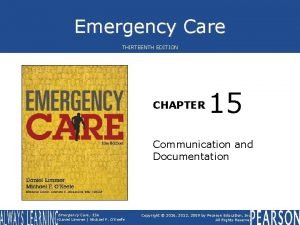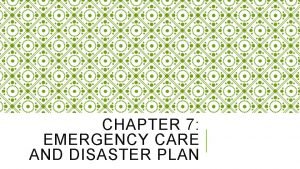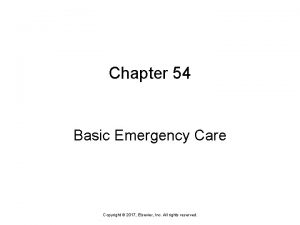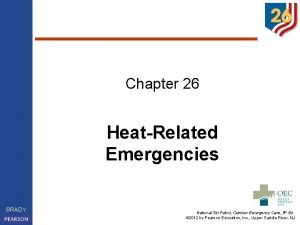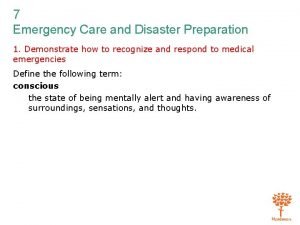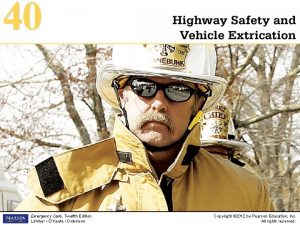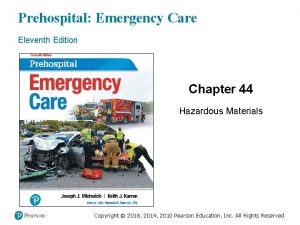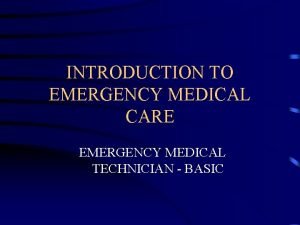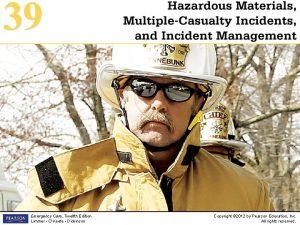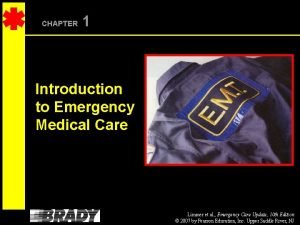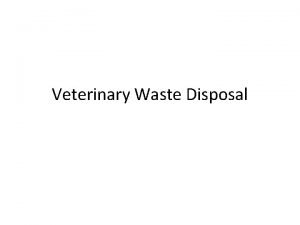Emergency Responses Jeopardy Veterinary Pet Care Agricultural Sciences

































- Slides: 33

Emergency Responses Jeopardy Veterinary Pet Care Agricultural Sciences Waterford, WI

First Response Heimlich Maneuver CPR Poisoning Car Accident Misc $100 $100 $200 $200 $300 $300 $400 $400 $500 $500

First Response • What is the first thing you should always do in an emergency? • Check to make sure the scene is safe •

First Response • This is what the CAB’s stand for • Circulation, Airway, Breathing

First Response • Before leaving for a veterinarian, you should do this. • Call the vet to alert them of your pending arrival

First Response • If a dog is not breathing but has a heartbeat, what would be the appropriate response? • Rescue Breathing

First Response • If a dog is not breathing and has no heartbeat, what would be the appropriate response? • CPR

Heimlich Maneuver • If a dog is choking, this would be the appropriate first response to address the choking problem: • Try to remove the object by hand

Heimlich Maneuver • To perform the Heimlich on a dog, you must do what general motion? • 5 thrusts inward and upward on the abdomen below the rib cage

Heimlich Maneuver • Where should your fist be placed to perform the Heimlich? • Below the rib cage

Heimlich Maneuver • If you cannot pick up the dog, what should you do to perform the Heimlich? • Lay the dog on its side and perform the compressions on the abdomen from the side

Heimlich Maneuver • If the dog goes unconscious while you are trying to expel the object from its windpipe, what should you do? • Keep performing the Heimlich until the object is expelled, then perform rescue breathing if needed.

CPR • CPR is needed under what 2 conditions? • No pulse and no breathing

CPR • Where should chest compressions be performed on a dog for CPR? • Widest part of the chest -ORleft side of the chest of the dog w/ the right side facing down.

CPR • How deep should the chest compressions go? • 1 -2 inches on a big dog; ½ - 1 inch on a small dog

CPR • If you are with a person, you perform ____ compressions for every breath. If you are alone, you perform ____ compressions for every 2 breaths. • 15; 30

CPR • If the dog is small, they should face _____ you during CPR. If the dog is large, they should face _____ you during CPR. • Towards; Away from

Poisoning • If you have to make a dog vomit, you would use this • 3% hydrogen peroxide

Poisoning • This is the rate you would give 3% hydrogen peroxide to make a dog vomit • 1 teaspoon for every 5 lbs of body weight up to 9 teaspoons

Poisoning • If you have to take the dog to a vet, you should bring these two things along. • The poison and the vomit

Poisoning • You should do this before making a dog vomit using hydrogen peroxide. • Try to feed it moist dog food or bread.

Poisoning • This is the number for ASPCA Poison Control • (888) 426 -4435

Car Accident • If you see a dog hit by a car, you must first do this before responding • Make sure the scene is safe

Car Accident • If you suspect a spinal injury from a car accident, you should do this as a precaution to prevent further spinal injury • Not move the dog unless you have to and/or use a board or blanket to move the dog

Car Accident • This is the first thing you should check when treating an animal hit by a car • CAB’s

Car Accident • If a dog has eviscerated organs, you must do this. • Keep them moist

Car Accident • This is what you should do to the dog on the way to the vet to prevent shock. • Cover it with a blanket

Misc • When treating an animal with heatstroke, this is the appropriate way to cool it down. • Cover with a towel and douse it with tepid water.

Misc • This is how you would treat a penetrating chest wound. • Cover the wound with a pad covered in antibiotic gauze or petroleum jelly and transport to the vet

Misc • If the dog has an object embedded into its body, you would do this: • Leave the object in place and secure with gauze, tape, or a foam coffee cup. Transport to the vet

Misc • If the dog has a fractured or broken bone, this is what you would do to prevent further injury before transporting to the vet: • Wrap the affected area in a towel and secure with tape

Misc • This is how you treat frost bite: • Wrap the affected areas in a warm towel or soak in tepid water

FINAL JEOPARDY • Make your wagers! • This is how you would respond to an animal that has been badly burned by a pot of scalding water. • Rinse off the affected area with cool water if possible. – Cover the affected area with a cool, wet cloth or cold pack and wrap in a loose bandage. – Transport the animal to the vet; cover with a blanket to prevent shock and call before leaving.
 Brno university veterinary medicine
Brno university veterinary medicine Paten brno
Paten brno Danish institute of agricultural sciences
Danish institute of agricultural sciences Human sciences tok definition
Human sciences tok definition Vet tech jeopardy
Vet tech jeopardy Nutrition jeopardy
Nutrition jeopardy Types of care primary secondary tertiary
Types of care primary secondary tertiary Emergency care system framework
Emergency care system framework Prehospital emergency care 10th edition
Prehospital emergency care 10th edition Therapeutic communication techniques
Therapeutic communication techniques Pa wc bureau
Pa wc bureau Enfield ems
Enfield ems Emergency care 13th edition chapter 1
Emergency care 13th edition chapter 1 Emergency care and disaster preparation chapter 7
Emergency care and disaster preparation chapter 7 Chapter 54 basic emergency care
Chapter 54 basic emergency care Outdoor emergency care 6th edition
Outdoor emergency care 6th edition Care for a victim of an immunologic emergency
Care for a victim of an immunologic emergency 7 pillars of urgent and emergency care
7 pillars of urgent and emergency care Chapter 8 emergency care first aid and disasters
Chapter 8 emergency care first aid and disasters Emergency care and disaster preparation
Emergency care and disaster preparation Prehospital care 11th edition
Prehospital care 11th edition Prehospital emergency care 11th edition
Prehospital emergency care 11th edition Prehospital emergency care 11th edition
Prehospital emergency care 11th edition Golden rules of emergency care
Golden rules of emergency care Introduction to emergency medical care
Introduction to emergency medical care Emergency care harrow
Emergency care harrow Emergency care system framework
Emergency care system framework Prehospital emergency care 11th edition
Prehospital emergency care 11th edition Introduction to emergency medical care
Introduction to emergency medical care Medical
Medical The goal of modern emergency care includes
The goal of modern emergency care includes Emergency care limmer
Emergency care limmer Introduction to emergency medical care
Introduction to emergency medical care Disposing of veterinary clinical waste
Disposing of veterinary clinical waste












